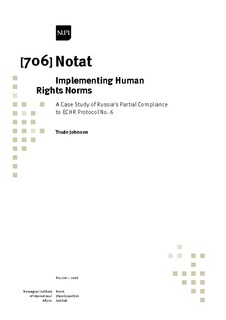| dc.contributor.author | Johnson, Trude | |
| dc.date.accessioned | 2016-07-01T14:46:38Z | |
| dc.date.accessioned | 2016-07-04T07:27:45Z | |
| dc.date.available | 2016-07-01T14:46:38Z | |
| dc.date.available | 2016-07-04T07:27:45Z | |
| dc.date.issued | 2006 | |
| dc.identifier.citation | Working Paper, NUPI nr706. NUPI, 2006 | nb_NO |
| dc.identifier.isbn | 82 7002 138 5 | |
| dc.identifier.issn | 0800 - 0018 | |
| dc.identifier.uri | http://hdl.handle.net/11250/2395369 | |
| dc.description | - | nb_NO |
| dc.description.abstract | In December 1991, Russia started down the road of its post-Soviet existence.
The re-emergence of Russia as a separate, independent entity compelled the state to
come to terms with its revived national identity. Russia’s relationship with the West lay at
the core of the challenge to define what Russia is and how it should relate to the outside
world. Opinion divided over whether Russia should rapidly integrate with Europe and
“return to the civilized community of nations” or whether it should seek “a strengthening of
Russia’s positions in the East” and rather pursue its unique mission as a mediator between
the East and West.
Against this backdrop I have analysed Russia’s membership in the Council of Europe (CoE)
and Russia’s partial compliance to the European Convention on the Protection of Human
Rights and Fundamental Freedoms (ECHR) Protocol No. 6, which refer to the abolishment
of the death penalty in peacetime.
Employing constructivist insights, I argue that this partial compliance is explained by the
lack of a coherent and widely accepted national identity. Due to different perceptions of
Russia’s identity among various state actors, identities collide, and interests, and consequently
action, will be in a competing and conflictual relationship to each other. Thus, norm
compliance is challenged when identities overlap and their norms conflict. This, I argue, is
evident in Russia’s relationship with the European ideational community and the country’s
dealing with the death penalty issue. The more Russian state actors value the European
identity of their state, the more they will seek to comply with “European” norms, such as the
strong European abolitionist norm, and vice versa.
In my analysis, I also discuss whether it is right to completely dismiss rational explanations
to Russia’s partial compliance. In this way I bring my case into the midst of the
rational–constructivist debate in International Relations theory. Contributing to this debate, I
investigate whether an either-or approach is the most productive way of explaining Russia’s
ideational behaviour or whether rational and constructivist assumptions combined may shed
new light on how to understand Russian compliance with international human rights norms
or the lack of such. | nb_NO |
| dc.language.iso | eng | nb_NO |
| dc.publisher | NUPI | nb_NO |
| dc.relation.ispartofseries | NUPI Working Paper;706 | |
| dc.rights | Navngivelse-Ikkekommersiell-DelPåSammeVilkår 3.0 Norge | * |
| dc.rights.uri | http://creativecommons.org/licenses/by-nc-sa/3.0/no/ | * |
| dc.title | Implementing Human Rights Norms : A Case Study of Russia's Partial Compliance to ECHR Protocol No. 6 | nb_NO |
| dc.type | Working paper | nb_NO |
| dc.date.updated | 2016-07-01T14:46:38Z | |
| dc.source.pagenumber | 69 p. | nb_NO |
| dc.identifier.cristin | 1365737 | |
| dc.subject.keyword | Humanitære spørsmål / Humanitarian issues | |
| dc.subject.keyword | Russland og Eurasia / Russia and Eurasia | |

